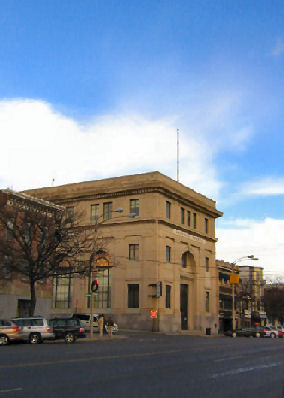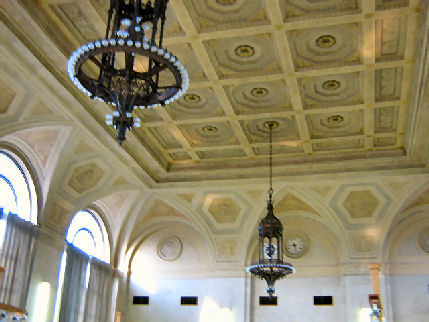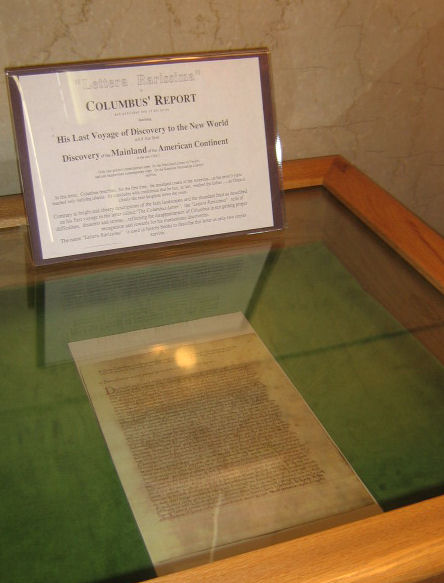Karpeles Manuscript Library Museum
94 Broadway
Newburgh,
New York 12550
845-569-4997
 David Karpeles, was born in Santa Barbara, California, on
January 26, 1936. His family moved to Duluth, Minnesota in 1942. He began
his own business at the age of six selling flowers and portrait discount
coupons, earning over $2000 in two months. He attended Munger Elementary,
Longfellow Elementary, West Junior High, and the Denfield High School
graduating in 1953. He entered the University of Minnesota at Duluth as
both a mathematics major and a physics major.
Co-started the Darling Observatories Astronomy Group, taking over the
local observatory and opening it free to the public at age 17. He served
as a substitute instructor at the University of Minnesota in Duluth and
graduated at the end of junior year, Cum Laude, with a bachelor of arts
degree, in 1956. Continued in mathematics as masters student at the
University of Minnesota in Minneapolis, working as a graduate instructor
(aged 20) in the department. Accepted a programmer and research analyst
position at Remington Rand Univac in St. Paul and transferred to Remington
Rand Univac facility in San Diego, serving as the training coordinator
between the Navy and Univac. Taught in extension Department of University
of California. Completed master's degree in mathematics in 1962 from San
Diego State University. Moved to Santa Barbara, California as a research
analyst for General Electric Tempo division in 1963. Taught mathematics at
Santa Barbara City College, began real estate investment business, and
worked toward a Ph.D. at the University of California at Santa Barbara
while working at General Electric Tempo. Completed Ph.D. coursework in
1971, but did not attempt to complete the program by writing a thesis.
Began collecting historical documents in 1970. David Karpeles, was born in Santa Barbara, California, on
January 26, 1936. His family moved to Duluth, Minnesota in 1942. He began
his own business at the age of six selling flowers and portrait discount
coupons, earning over $2000 in two months. He attended Munger Elementary,
Longfellow Elementary, West Junior High, and the Denfield High School
graduating in 1953. He entered the University of Minnesota at Duluth as
both a mathematics major and a physics major.
Co-started the Darling Observatories Astronomy Group, taking over the
local observatory and opening it free to the public at age 17. He served
as a substitute instructor at the University of Minnesota in Duluth and
graduated at the end of junior year, Cum Laude, with a bachelor of arts
degree, in 1956. Continued in mathematics as masters student at the
University of Minnesota in Minneapolis, working as a graduate instructor
(aged 20) in the department. Accepted a programmer and research analyst
position at Remington Rand Univac in St. Paul and transferred to Remington
Rand Univac facility in San Diego, serving as the training coordinator
between the Navy and Univac. Taught in extension Department of University
of California. Completed master's degree in mathematics in 1962 from San
Diego State University. Moved to Santa Barbara, California as a research
analyst for General Electric Tempo division in 1963. Taught mathematics at
Santa Barbara City College, began real estate investment business, and
worked toward a Ph.D. at the University of California at Santa Barbara
while working at General Electric Tempo. Completed Ph.D. coursework in
1971, but did not attempt to complete the program by writing a thesis.
Began collecting historical documents in 1970.
While at General Electric, he created the first operating optical
character recognition program. This program automatically read the figure
amounts on bank checks in order to print that amount magnetically on the
margin of the check. Developed an artificial intelligence program allowing
personnel to question a computer using unrestricted English language. The
program analyzed the syntax of the question, determined the meaning
and gave the appropriate answer.
The first Karpeles Manuscript Library in Montecito, California opened in
1983 with these words from David Karpeles:

"As a child I remember a world filled with hope and pride. Those who had
pursued their goals, whether successfully or not, reflected their pride
and fulfillment. One could feel their excitement in their desire to follow
their new and future goals. Those of us too young had hope and looked to
the inspiration of our predecessors to give us purpose.
The world is no longer so filled. There is little hope and little pride.
Our children have no sense of purpose and few goals. They make no
commitments for fear that they will make mistakes and fail. They see our
mistakes but are blind to our accomplishments. Their emptiness spreads
over us all.
I for one, will not accept this. I wish to renew that feeling I had as a
child; that hope, that pride, that sense of purpose. I believe that we
learned those feelings by our exposure to the accomplishments of our
predecessors. We studied history; we studied literature, we studied
government, science, philosophy, art and music. Our children have not.
They do not know who is Simon Bolivar, Rudyard Kipling, Immanuel Kant,
Franklin Pierce, Sir Walter Raleigh, Virginia Dare or Queen Isabella. They
are hardly aware of the the quest for the Indies, the origin of the
species, the discovery of vaccines, the Reformation, the Black Plague,
Esperanto, the Peer Gynt Suites, the Rubaiyat, the Magna Carta.

It is to cure this lack and thereby fulfill my own desire to renew the
sense of purpose for our children and ourselves that the Karpeles
Manuscript Library has been created."
There are are now Karpeles Manuscript Library Museums in Santa Barbara,
Buffalo, Jacksonville, Tacoma, Newburgh, Charleston and Duluth and they
are open daily to the public featuring a rotating exhibit designed to
focus on no more than 25 documents at any one time.
The following partial
list of special exhibits, which covers the fields of History, Music,
Science, Literature, and the Arts, gives the extent of the breadth of the
holdings:
Charles Darwin; Letters from the Pen; Dreyfus; Flight before the Wright
Brothers; Lindbergh; Thomas Jefferson; Will Durant and the Age of Reason;
Early 20th Century Book Illustrations; the American Indians; American
Independence; the Discovery of the New World and Great Maps; the Discovery
of the New World and the Great Explorers; Webster and the Dictionary; the
American Civil War; Music and the Great Composers; the Bill Of Rights of
the American Constitution; the Wizard Of Oz; Polar Exploration; the
Constitution of the United States; Napoleon Parts One and Two; the Spanish
Armada; the Confederate States of America Collection; Hitler's Speeches;
16th-Century English Royalty; and Women's Literature
Each of these exhibits include documents of monumental importance in the
field:
Historical exhibits in the past include The Original Proposal Draft of the
United States Bill Of Rights; the Emancipation Proclamation Amendment to
the United States Constitution; signed by Abraham Lincoln; The
Justification letter which accompanied The Declaration of Independence,
signed by John Hancock; The Thanksgiving Proclamation of the United
States, signed by George Washington; The Final Declaration of Allegiance
Treaty signed by every Indian tribe in the United States and by the
President of the United States; and the original autograph drafts of the
National Constitutions of France; Spain; Mexico; Ireland; and the
Confederate States of America
Music manuscripts which have been on exhibit include pages of
Beethoven's Emperor Concerto; Mozart's Marriage of Figaro; Wagner's
Wedding March; Handel's Messiah (in Beethoven's Handwriting); Liszt's
Hungarian Rhapsody; Strauss's Blue Danube; and Puccini's Madam Butterfly.
Also shown were written items from composers and lyricists including
Verdi's Aida; William S. Gilbert's Pirates of Penzance and Even Effie
Canning's Rock-A-Bye Baby.
Scientific manuscripts have also been featured, including: Galileo's
announcement marking the beginning of the science of mechanics; Kepler's
manuscript on the Law of Planetary Motion; Einstein's Theory of
Relativity; Freud's manuscript on dreams; Morse's archive on the
telegraph; Marconi's archive on the radio; and Darwin's Conclusion to his
Theory of Evolution, "Survival of the Fittest". Also preserved are
important manuscripts of Descartes, Newton and Edison.
The breadth of topics, preserved at the Karpeles Museum, range from Pope
Lucius III's Proclamation of the Sacred Duties of the Knights of the Holy
Crusades, signed in the year 1183, to the Surrender Agreement of World War
II.
Admission is free at all locations. Click
on map icon for this museum's location Click
on map icon for this museum's location |